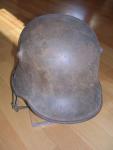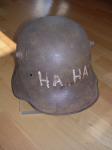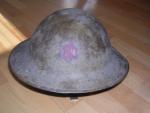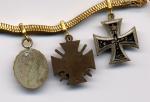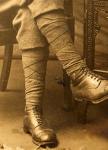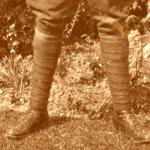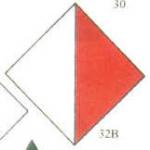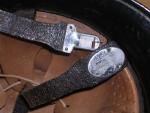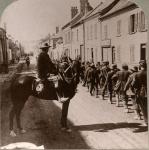-
Posts
3,687 -
Joined
-
Last visited
-
Days Won
2
Content Type
Profiles
Forums
Blogs
Gallery
Events
Store
Everything posted by Tony
-
This is an Austrian issue helmet fitted with the M31 liner. It appears to have 3 holes filled at the front top, can anyone explain that? Tony
-
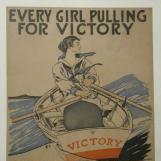
German Dog Tags Enquiry
Tony replied to philsidey's topic in Germany: Third Reich: Research, Documentation & Photographs
It was a POW camp in Poland, try this site: http://www.pegasus-one.org/pow/pSt_344.htm Tony -
Ok Jim, I'll try to post the other pics tonight after I get back from taking my son to his swimming lesson. The Russian M15 is a bit of a mess though so don't expect much. Tony
-
-
-
Hello Jim, The only other FS I know about is Thomas Firth and Sons who supplied steel from Sept. 1915 to 1919. It could well be Firestone though being an American made tin hat. WWI steel is something I like too. I have a British made US used MKI, a Brit MKI, an Aussie rimless MKI, an Austrian with M31 liner, M16 sort of relic, M17, Belgian M15, 2 French M15s and a Russian relic M15. As this thread is only about US and German I'll just attach pics of those. Tony
-
Laurence, I just found this on the net which could be what you are looking for: 20 mm "mickhaque" case I was handed down a cartridge case which was found in our garden in Folkestone, England by my father in 1940. The base has the markings 'BMARO 1940 20mm ZI'. Would you know how I could track down its source? I assume it was a German aircraft origin. Many thanks: Martin Headstamp of the case is actually "BMARC", abbreviation from words "British Manufacturing And Research Co." (A loader of 20 mm Hispano-Suiza cartridges in Grantham, England). Letters "ZI" denotes use of nitro-cellulose propellant (powder), loaded into those cartridges, which must function in very cold climate, like altitudes of the sky. Therefore it was preferred over Cordite propellant for cartridges of aircraft weapons. Powder manufacturer has been Imperial Chemical Industries. "1940" is year of manufacturing and "20 mm" denotes the calibre. The case was presumably dropped from Supermarine "Spitfire" or some other British fighter aircraft during a dog-fight. Word "mickhaque" is somewhat irrelevant, meaning a small long-barreled cannon, calibre 20 to 30 mm. These infantry cannons with light carriages were used as a sniping firearms during 16th Century in Scandinavia, including Finland, and North-West Russia. In Swedish the word was spelt as "mickhake" and in Finnish as "nikhaka". In French the name of these firearms was "amusette". Many times they were breech-loaders, already in 16th or 17th Century. Hispano-Suiza aircraft cannons shot burst or full-auto fire, of course. This is the site I found it on http://guns.connect.fi/gow/QA8.html Cheers Tony
-

Heer Afrika Korps cuff titles
Tony replied to Tony's topic in Wehrmacht Medals, Decorations & Awards
Bummer! Well that's one well known German dealer from Hamburg to be wary of (wasn't DN). I paid 30 Marks for that in 1987. Back then a packet of smokes from the naafi were only 2.20 Marks. Tony -

A few soldiers that I`ve researched.....
Tony replied to bigjarofwasps's topic in The Great War 1914 to 1918
Hello Ray, This is Andrew Hesketh's internet site http://www.derbyshirelads.uwclub.net/ it is full of info on the Sherwoods and has the full contents of Sid's diary. Andrew is is a very helpful bloke and I'm sure he wouldn't mind if you asked him any questions. If you would like me to send you a CD with scans let me know by PM. Re your posts: It looks like you've got the problem sussed now. Tony -
Hello David, I've never heard of the Matador before. Our squadron had AEC MKIII Militants and 1 Knocker but I must say, they do all look alike. Below is a Matador I just found on the net. If I can find some of my old pics of a Milli and Knocker I'll post them too. Tony
-
Is the last lorry in this pic British or German? It isn't very clear and it says "on the road to Dunkirk May 1940" on the back. It looks like an AEC Knocker to me (don't know if that's the correct name but it's what we called them). Was anyone else here in the RCT once upon a time? Tony
-
Bob, I wore puttees in the army too, not the long ones though, we had the short ankle puttees. Quite easy to wrap after a few weeks practice, knowing exactly where to begin so that the triangle end was positioned correctly was the problem. I've been told WWI puttees were crossed as in the above pic because when wet they tended to stretch and would loosen after drying. They could be a bit of a bugger when charging the enemy or running away from him even. Tony
-
I was looking at some of my Great War photos today and noticed a difference in the way the two soldiers below had wrapped their puttees. Does anyone know the reason why one has them done it in what I would term the normal way and the other sort of criss cross? I tried copying the way they were done and didn't quite manage it as they are far too long. Tony
-

Australian Light Horse?
Tony replied to Tony's topic in Great Britain: Militaria: Badges, Uniforms & Equipment
Arthur, Thanks for the link. Unless he's sewn it on the wrong way round he must be a member of the 1st ANZACS. Tony -

Policeman's helmet
Tony replied to Tony's topic in Germany: Third Reich: Uniforms, Headwear, Insignia & Equipment
Hello Ibsr, I've attached a picture of the chinstrap, as you can see, the catch seems to be missing. Tony -
Hello, As we don?t often see pics of Commonwealth soldiers (although most of them here are German) I thought I?d show a stereo view of what appears to be an Aussie officer. I don?t know where the photo was taken but it reads ?prisoners coming in after repulse at Hangard and Villers Bretonneux.? The Lieutenant on his horse has a shoulder rank as opposed to cuff rank. Does anyone recognise his divisional patch? It?s a diamond with 2 vertical colours, the lighter shade being towards his back. 1st ANZAC Mounted Regiment?? Tony
-
Hello Angel, I seem to remember a lot of people having the nickname ferret when I was in the army, had nothing to do with any particular unit though. In WWII German guards would plant equipment to detect tunnelling and lie under huts eavesdropping on the prisoners or carry out raids on selected huts without warning if the men inside were thought to be up to no good. Because of their job, the allies gave them the nickname ferret. I just wonder if the name stems from tunnelling fatigues or if British camp guards did the same in the Great War. Tony
-

WW2 Ribbon bar I.D. needed
Tony replied to Grant Broadhurst's topic in Great Britain: Militaria: Badges, Uniforms & Equipment
Hello Grant, I think you are correct about the first 2 being the 39-45 Star and Burma star but I'm not sure about the last one being the Defence Medal. This might help you though, it's the requirements for receiving the Defence and War Medals: Defence Medal Service in the Forces in non-operational areas subjected to air attack or closely threatened, providing such service last at least three years. Non-operational service in the Forces overseas or outside the country of residence, providing that this service lasted for at least one year. If the territory was threatened by the enemy, or subjected to air raids, the duration requirement was reduced to six months. Civil defence in military operational areas providing these civil defence activities were not eligible for campaign stars. Members of any of the civilian services entitled to wear chevrons for their war service were eligible for this medal. Members of the Home Guard resident in the UK, who had completed at least three years service. Recipients of the George Cross or George Medal, regardless of their occupation, provided the George Cross or George Medal were won for service in civil defence. War Medal This medal was awarded to all full-time personnel of the Armed Forces. Operational and non-operational service of at least 28 days counted. The Merchant Navy requirement stated that the 28 days minimum should be served at sea. The recipient was awarded this medal if their service period was terminated by their death, disability due to service or capture as a prisoner-of-war and their service qualified them for one of the stars. Also if the recipient had received one of the stars for a service period of less than 28 days, they were also awarded the War Medal. Tony -
Chris, This might give you some idea, it's an ebay auction in jolly old England 6552381963. I wanted one a few years back but found the originals far too expensive for something that is hidden away in the gun cupboard and only comes out now and then to have the potatoes and carrots growing down the barrel removed so, I bought myself a repro holster for 40 quid. Tony
-
Hello Mr B (the original), I thought the enamelled ones were all private purchase German made. Tony
-
I didn't notice the star was the wrong way round too Rick. I was hoping though that only a few navy personnel were there. The name of the photographer was Kreuzer which is rather fitting for a sailor but his studio was in Mindelheim, way down south in deepest darkest Bavaria just to the west of Munich. I think it would take you the best part of a day to get to the North Sea or Baltic today (unless flying), so a train journey back then must have taken yonks. Tony



